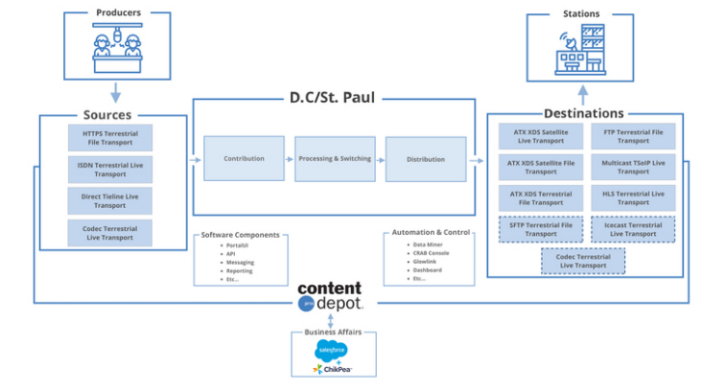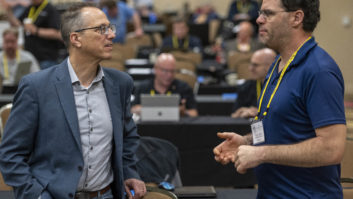Last month, just prior to the 2023 NAB Show, the Association of Public Radio Engineers held its annual Public Radio Engineering Conference (PREC), which featured several noteworthy speakers.
Prompted by his PREC presentation about the future of radio distribution, Radio World reached out to Michael Beach, the vice president of distribution for National Public Radio, to learn more about NPR’s Request for Proposal (RFP) for the “Investigation of the Future of Public Radio Content Distribution.” Beach responded to our queries via email.

Radio World: This sounds like a huge topic; what exactly is this request for proposals about?
Michael Beach: The intent is to help us in our discovery phase. What that means is we seek to understand what business needs and technical gaps exist that might be improved from the network level. NPR Distribution has a basic B2B mission to get national content to individual stations in an automated way. Can we do that better? Are there needs at local stations that we could also help with? Are there better ways to coordinate support to stations? Are there ways we can better collaborate with our PBS colleagues?
RW: Who is funding the RFP and the work that the chosen consultant will do?
Beach: We have been working through this approach with the Corporation for Public Broadcasting (CPB) and have a proposal in front of them currently.
RW: Why is this RFP seen as necessary? Is the current system not sufficient or not meeting public radio’s needs?
Beach: The current system works well every way we measure it, and our stakeholders are consistently complimentary. The RFP is not about current public radio needs, but about the future. In technology and in media there is no such thing as standing still. You’re either adapting to the changing environment or falling behind.
RW: Briefly describe public radio’s current distribution infrastructure.
Beach: The current infrastructure carries hundreds of thousands of hours of public radio content annually. About 80 percent of that content consists of live streams. The rest is file-based audio and metadata. We do this consistently at a high service level availability (SLA) month in and month out.
Our contribution system includes public and private terrestrial and satellite feeds for live content. File-based content generally comes to the network headend via the internet. Once on site the content is quality checked, combined and distributed via the ATX system. We send the outbound traffic across satellite, private IP connections, and public Internet to nearly 400 interconnected stations. These interconnected stations in turn feed about 1600 transmitters and translators in local and regional networks. All of this activity is managed through an in-house tool we call Content Depot. It acts as a clearing house of content for national producers and local stations. Content Depot is also monitor and control tool for all our systems at the main network operations center (NOC) in Washington DC as well as our backup (BUNOC) in St. Paul, Minnesota. The NOC is staffed 24/7 to perform quality control and respond to any issues that come up. They are supplemented by a help desk for support to stations.

RW: When was the last time such a project or assessment of the system was done?
Beach: About six years ago we went through a technical RFP that brought about our migration to the current ATX system. At that time, we engaged several consultants to look at different aspects of our traditional service (national content to local stations). We also conducted our own research. At that time, CPB engaged a consultant to review our plans and comment on our proposed approach. This new RFP is different in that we will be looking at business needs that may reach beyond the traditional role of NPR Distribution. For example, over the past few years we have been helping stations add metadata to their broadcast and online streams. Should we as an entire public radio industry approach that in a more holistic way?
RW: What are the major “deliverables” that the consultant who wins the RFP will be expected to provide?
Beach: The consultant will supply a set of reports, each described in the RFP. They include key findings and recommendations, business needs, a technical assessment and a connectivity study.
RW: A connectivity study is one of those deliverables. Why is that needed?
Beach: As we look to the current balance of satellite, private and public terrestrial connections, we need to see if there are opportunities to shift that balance and still maintain the quality of service to every public radio station in America (including USVI, Puerto Rico and Guam). If there are opportunities to lower costs while meeting the same high expectations of public radio stations and listeners, then we should consider them. The connectivity study is intended to look at public and private terrestrial bandwidth available at each of our specific locations to see how many vendors offer connections. We also want to know how each local vendor defines “broadband” and what those connections might cost.
RW: The RFP refers to an “IP-first/digital distribution landscape.” How far away are you from having that today?
Beach: Our system has been IP-based for more than 15 years. That part is not new. In terms of digital distribution (B2B) we think of the satellite and terrestrial balance spoken of above. In addition, stations and producers increasingly look at online ways to offer their content to listeners (B2C). The research may show gaps that NPR Distribution can support, or at least if a more global approach by the public radio system can be helpful.
RW: What is the timetable for the RFP and ensuing steps?
Beach: We intend to award the consultant bid by mid-summer. The time needed to gather the data will be a function of the consultant’s process. The deliverables in this RFP will inform a follow-on technical RFP to help us select any future technology. That second RFP will not likely start until early in 2024.
RW: What else about this project would a radio engineer or manager working in or around public radio want to know?
Beach: The best way for us to consider future technical systems is to have the best information possible about the business needs and vision of our stakeholders. Technology should support the business, but it can inform the business in some ways as well. The key is participation. The more content producers and stations take part in this process, the better information we’ll have, and the more likely we are to make the best technology decisions as a public radio industry.











